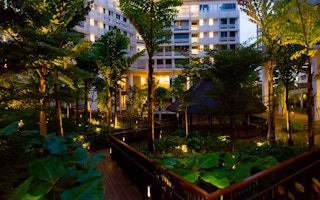Just as the prolific American bank robber Willie Sutton confessed to robbing banks because “that’s where the money is”, global efforts to reduce greenhouse gas emissions must focus on the building sector because “that’s where the carbon is,” said leading green building researcher Stephen Selkowitz.
Speaking at a plenary session on sustainability leadership at the International Green Building Conference on Monday, Selkowitz noted that buildings account for 40 per cent of all energy consumption in the United States, and apart from environmental benefits, there are also huge economic opportunities in pursuing energy conservation.
Selkowitz said that the US Energy Information Administration (EIA) estimated that American consumers will spend US$4.61 trillion less on energy between 2013 and 2030 than was originally projected in 2005, due to the increase in the energy efficiency of buildings.
If more energy efficiency technologies and solutions are implemented to further reduce energy demand from buildings, an additional US$1.94 trillion of savings was is possible just in America alone, said Selkowitz, who is the group leader for the Windows and Building Envelope Materials Group at the Lawrence Berkeley National Laboratory in California.
At the discussion, Selkowitz and his co-presenter, Professor Bertil Andersson, president of Singapore’s Nanyang Technology University (NTU) - whose EcoCampus initiative aims to transform NTU into the ‘greenest campus in the world’ - shared three key strategies for spurring the adoption of green building practices.
1. Setting a clear vision and ambitious targets
Ensuring that buildings deliver on the energy performance promises they make and striving for zero-energy buildings are two examples of targets that are ambitious, and would make a significant difference to the energy consumption profile of buildings, said Selkowitz.
He added that the way occupants use and behave in a building after it is constructed is not something that is easily controlled by developers. But steps can be taken during the design and construction stage to guide occupant behaviour towards maximum energy savings, which would also help them cut costs. Possible strategies include designing intuitive and highly controllable lighting systems and providing training for office occupants on using these new energy saving technologies.
“When a building is made, the physical structure may be certified with a Green Mark, but nobody knows how it will perform over time. The idea of predicting and even controlling how occupants use energy in a building makes architects and engineers nervous, but this is an important challenge to think about,” he said.
“This is where information technology can play a role in accurately predicting a building’s life cycle energy use, and Singapore is a leader in this area. Guaranteeing building performance could imply major changes in how we design and operate buildings,” added Selkowitz.
Striving to make more buildings ‘zero net energy’– that is, a building that does not use more than the renewable energy it is able to generate on-site – was also a target that Selkowitz said the building sector should be striving for.
“There are currently 150 zero energy buildings in the United States, which sounds great until you realise this is out of a total 5 million buildings. The challenge is how can this be scaled up?,” said Selkowitz.
“The smaller, easier buildings such as warehouses and low-rise structures can be tackled first, and the more complex high-rises, hospital, and data centres can be addressed later,” said Selkowitz, adding that “the challenge of moving to zero energy is going to be easier for more innovation-oriented developers”.
“Pursuing zero energy buildings is definitely not a trivial target, but there are a lot of opportunities in doing so,” he said.
2. Focusing on integrated green building solutions
“
When a building is made, the physical structure may be certified with a Green Mark, but nobody knows how it will perform over time. The idea of predicting and even controlling how occupants use energy in a building makes architects and engineers nervous, but this is an important challenge to think about.
Stephen Selkowitz, group leader of Windows and Building Envelope Materials Group, Lawrence Berkeley National Laboratory
Selkowitz shared a case study of a series of retrofits to the New York Times’ headquarters – including implementing prism technology to reflect natural daylighting deeper into the building interior, installing automated shading to manage the building’s cooling load, and using sensor technology to monitor and adjust ambient light and temperature according to a room’s occupancy levels.
This helped the company cut down their energy use by a quarter and increased occupant comfort, according to Selkowitz.
The case study was an example of the importance of applying integrated building systems – where various components such as lighting, cooling and ventilation, electricity consumption are interconnected and adjusted – to help reduce energy use, he said.
“In the past, changing individual components such as light-bulbs has helped achieve savings of up to 30 per cent,” said Selkowitz. “But to get to the level of savings you need to have a net zero energy building, integrated systems is the way”.
“It is challenging to understand how they work,” he acknowledged, and added that one such effort to better understand integrated systems is the Flexlab at Lawrence Berkeley National Laboratory. This is a unique facility that consists of four test beds where users can trial energy efficient features such as skylights, window materials and cooling systems on a small scale before implementing them in commercial projects.
The laboratory is also working with Singapore’s Building and Construction Authority (BCA) to develop a similar facility here, which is slated to be completed next year. The new facility will be installed on the rooftop of the BCA Academy, and will allow researchers and manufacturers to experiment with building systems and components till they find the most energy efficient configuration for their projects. The entire test-bed structure will be able to rotate in order to test impact of sunlight from different angles and on different wall surfaces, making it the first rotating research facility in Asia.
3. Developing innovative technologies through industry collaborations
In Singapore, NTU president Bertil Andersson shared that the university has offered itself up as a test-bed for emerging green building technologies, and is collaborating with multinationals such as Siemens, BMW, Rolls Royce, IBM, and Bosch to do this. The organisations will jointly develop and install features such as solar panels, dual refuse chutes to promote recycling, double glazed windows to keep cool air in, and passive ventilation technologies to reduce the need for air conditioning.
“When we discuss energy systems for buildings, we look at mature technologies, but should also invest in more futuristic energy systems to solve this challenge,” said Andersson. “We have plans to build S$2 billion worth of new buildings, and this presents a great opportunity to use the campus as a test-bed to bring new technology to market.”
Andersson also said that while such technologies exist worldwide, “test-bedding and research is essential in Singapore to make sure these technologies are adapted effectively in the tropics.”
He shared that over the next five years, the university hopes to achieve energy savings equivalent to the energy needed by 16,500 HDB units per year, save as much water as 220 Olympic sized swimming pools and reduce waste by a weightage equal of that of 505 Asian elephants.
“Singapore is such a vibrant and modern Asian city, and as a technology university, we are playing our part in making it more sustainable by working with industry partners and organisations rather than hiding in our academic towers,” said Andersson.
Our special event coverage of the International Green Building Conference 2014 is brought to you by City Developments Limited (CDL).






















